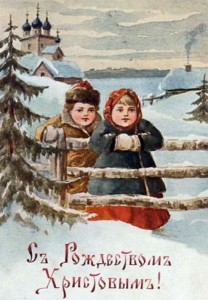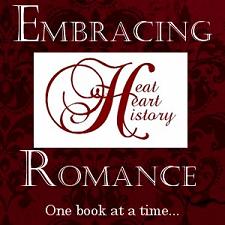Christmas in Imperial Russia was celebrated with a blend of traditions from Russia’s Christian and pre-Christian past. On Christmas Eve it was customary for groups of people masquerading as manger animals to travel from house to house performing and singing carols known as kolyadki. Some kolyadki were pastoral carols to the baby Jesus, while others were homages to the ancient solar goddess Kolyada, who brought the lengthening days of sunlight through the winter. In return for their songs, the singers were offered food and coins before moving on to the next home. There is a passage in Leo Tolstoy’s War and Peace describing this custom, known as mumming. Everyone participated in the mumming. In the 17th century, the tsar himself, followed by his boyars and courtiers and led by drummers, would travel by sleigh from house to house in Moscow to sing for the owners. Peter the Great was also known to congratulate his friends in this manner, but he kept a list of participants and those who did not join were punished.
Religious observances surrounding Christmas also flourished in Imperial Russia. Though the foods and customs surrounding the observance of Christmas differed from village to village and family to family, certain aspects remained the same. Christmas Eve was the last day of the six week Christmas fast, and for the devout, ancient custom dictated that no one eat until the first star shone in the sky. Hay was spread on the table and covered with a white cloth in memory of the manger. Dinner began with a prayer for the New Year and a special porridge called kutya. The head of the household would throw a spoonful outside to encourage Grandfather Frost to spare the crops, then a spoonful was thrown up on the ceiling. The grains that stuck foretold the number of bees there would be in summer to ensure a plentiful honey harvest. Lastly, upon rising from the table, everyone left some kutya in their bowls for their departed relatives.
Bibliography: Massie, Suzanne. The Land of the Firebird: The Beauty of Old Russia. New York: Simon & Schuster, Inc., 1980.




Great piece! What has always amazed me is how, in a country where religous and holiday traditions were so prevalent and openly observed, it all fell apart after 1917. The postcards are wonderful.
Thanks for stopping by, Emma. I agree it is odd how the religious and holiday traditions seemed to just disappear. While in Moscow on a class trip in 1989, I attended an Orthodox service. Things had already begun to fall apart by then so perhaps they were more lenient at that time, but I suspect church services and holidays were being covertly celebrated for some time before that. I find it interesting that the government allowed the churches to remain. Perhaps because the buildings themselves were so valuable and not so much because of their historical and religious significance.
Wow- no Christmas until 1992? How sad. This is interesting, Ally. Thanks! My daughters throw macaroni on the ceiling. When it sticks- it’s ready. lol Of course, then mom has to get it down…
Calisa – thanks for coming by. So far I’ve been able to prevent them from throwing the oatmeal, but the oldest is trying to convince me that I’m hindering them from learning about history in a concrete way. LOL.
Great article, Ally. Having gone through the ‘cold war’ between the US and the Soviet Union, it seems strange to read about Christmas celebrations there. I grew up believing it was a godless nation. I’m glad everything was restored in 1992.
Thanks for stopping by, Callie. I’m planning a future post about how some of the Christmas traditions were transferred to New Year celebrations in the 1930s.
Loved your post Ally. Always great to learn new things and I definitely did here. The pictures of the postcards are beautiful. Thanks for sharing 🙂
Thanks for visiting, Christine. I find Russian history and culture absolutely fascinating, so I love sharing!
Ally,
Very interesting post. It’s always fascinating to hear about other customs. I thought it very interesting that the tsar participated in mumming. Thanks for sharing.
–Kirsten
Thanks for coming back, Kirsten. I enjoyed that tidbit about the tsars participating in the mumming, too. Reading about Peter the Great made me laugh. As much as he pushed to “westernize” Russia, he was very autocratic about it.
Great post. I love to read on traditions from the past and other countries. From what I gather Christmas in Russia is celebrated in January. Just as in former communist Yugoslavia any religion was forbiden and therefore Christmas. Only a handful of old people went to church, but many celebrated in secret until the regime couldn’t stop them any longer. The sad part is that many generations grew up thinking this is how it suppoesed to be celebrated, in shame. Well, things are different now thank God and in my home country now, Croatia everyone is free to observe whatever they celebrate at any time of the year.
Yes, Zrinka, you’re correct. In Russia they celebrate Christmas on January 7th because the Russian Orthodox church still follows the Julian calendar, which is 13 days behind our Gregorian calendar.
Croatia looks so beautiful. I hope to visit there one day. Thanks so much for stopping by.
What a great blog! I didn’t know that Christmas was banned there or that it wasn’t accepted again until such a late date!
That’s one of the things I love about writing historical fiction – I love all the interesting things I learn doing research for my books. I guess I’m just a history geek at heart. Thanks for coming by, Sharla.
Ally, That was a very good post. It’s always interesting to lean about different customs.
I agree. Thanks for stopping by, Ella.
Wonderful post–was listening to Tchaikovsky’s Waltz of the Snowflakes while reading your article. This is more about your previous post: I read somewhere that Alexander III gave the composer a life-time pension. So at least he had some recognition.
Alexander III awarded him the Order of Saint Vladimir and a lifetime pension. He was a favorite of the Imperial family and known for his other ballets, Sleeping Beauty and Swan Lake. I just find it so sad that he died without knowing how popular his music would become, with the Nutcracker being the most well-known of all.
Most post cards from imperial Russia are in pretty bad shape. Was it because of Communism? Did the Christmas Post cards have to be hid as best they could under the circumstances? Did having one connect you to the Czar somehow? Just wondering?